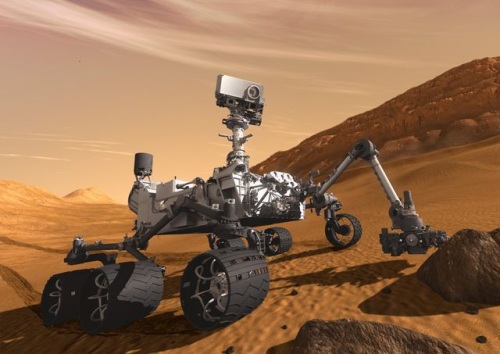This past week, NASA published a paper in Science Magazine that discusses a fairly major discovery made by the Curiosity Rover on the red planet: water exists in Martian soil.

Specifically, the 1-ton bot scooped up some soil and using its Sample Analysis at Mars instrument, heated the dirt to 1,535-degrees Fahrenheit to observe the gases that were released.
The bot saw significant amounts of carbon dioxide, oxygen, sulfur, and TONS of water.
Also observed: the soil water was rich in deuterium, a heavy isotope of hydrogen that contains one neutron and one proton (Earth-based hydrogen atoms have no neutrons). The water in Mars’ air has a similar deuterium ratio, which means the planet’s soil is, more or less, acting a like a sponge and absorbing water straight out of the atmosphere.
Obviously, this raises a ton of questions. Here are five points that hopefully answer the queries you might have.
1. How much water was discovered?
Approximately speaking, about 2% water by weight. This means that an astronaut could extract 2 pints of water, or 1 liter, out of 1 cubic foot of Mars-based dirt.
2. Is there anywhere here on Earth that has roughly the same water-to-dirt ratio?
In short, yes. As a matter of fact, the 2% moistness observed in Martian soil is wetter than many parts of the Arabian Gulf.
If you want to get really granular with comparing soil moisture in different areas of the world to what was discovered on Mars, check out this great CESBIO map.
3. Can this level of moisture support plant life?
Again, yes, but with some work. You see, the water discovered is part of the mineral structure that makes up the soil; that is, it’s not freely available for plants to use.
In order to get the water, a person (or robot) would have to be present to do exactly what Curiosity did — bake the soil a few hundred degrees for a few hours, collect the released materials to get the water vapor, and then deliver that water to the plant directly.
There are, obviously, some other minor stipulations — the warmest parts of Mars are equal to Antarctica; the coldest parts, meanwhile, are colder than anything we have here. Also, the atmosphere is really thin. While carbon dioxide is present, plants require nitrogen to live, and while there’s only a small amount of it on Mars, whatever does exist is in the form of nitric acid.
This is all not mentioning the fact that the planet is without an ozone layer which, in layman’s terms, does not bode well for any plant.
4. Is this the first-ever discovery of water on the red planet?
No. Back in June, Curiosity gathered a rock specimen that contained a type of clay that could only be formed in neutral water. This told the scientists that Mars, at one point in its billions of years of existence, was home to running water.
Also, researchers have long believed water did / does exist on the red planet due to all of the many formations it has on its surface. Judging by its landscape, a majority of scientists believe that water was available in abundance on the red planet.
5. It’s just 2%. Why is this considered such a big deal?
Two reasons: it means water is abundant on the planet, and it’s also easily accessible. Translation: people can be sent to the planet and, armed with the right tools, they can scoop up the soil anywhere on the surface, heat it up, and obtain water.
To learn more, read the paper the group published detailing the discovery in Science Magazine.
Advertisement
Learn more about Electronic Products Magazine





